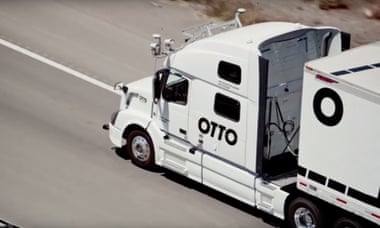Driverless trucks will be safer and cheaper than their
human-controlled counterparts, but that doesn’t mean America’s 3.5
million professional truck drivers are giving up to the machines without
a fight.
Across the US, truckers collectively haul more than 10bn tons of
freight each year, but it’s a tough job – the hours are long and lonely,
the pay is low and the lifestyle is sedentary. In many ways it’s a job
ripe for disruption; robots v truckers.
“Picture the taxi drivers around the world acting in response to
Uber,” says Andy Stern, the former former president of the Service
Employees International Union, referring to protests and violence that erupted in many cities as the $62.5bn Silicon Valley on-demand ride-hailing firm challenged conventional, regulated taxis.
“Truck drivers will follow a similar pattern,” says Stern. “There
will be disruption in different places. You can imagine people ringing
state capitals with their trucks.”
Much has been written about the advent of the driverless car, with rival versions being developed by Google, Uber and Tesla,
yet driverless trucks are likely to roll out at scale much sooner.
“Individuals can make their own choices about whether they want to get
into a driverless car or taxi, but labour-saving technology will be
deployed by businesses much quicker,” explains Stern, whose book Raising the Floor explores the need for a universal basic income as technology replaces jobs.
Mining giant Rio Tinto already uses 45 240-ton driverless trucks to move iron ore in two Australian mines, saying it is cheaper and safer than using human drivers.
Now the race is on to put driverless trucks on public roads. In May
2015, the first self-driving truck hit the American road in the state of
Nevada, and there have been several tests around the world since then including a convoy that drove across Europe to the port of Rotterdam
in April. That convoy used a new automated driving technology called
platooning, which connects trucks using Wi-Fi, sensors, GPS and cameras.
The leading vehicle dictates speed and direction, while the rest
automatically steer, speed up and slow down in close convoy.
In San Francisco, former Googlers have launched a startup called Otto, which promises to retrofit vehicles with driverless capabilities for just $30,000. The average trucker’s wage is around $40,000 per year.
https://www.theguardian.com/technology/2016/jun/17/self-driving-trucks-impact-on-drivers-jobs-us

"... It is only in this way that we can hope to arrive at truth, and fulfill the great responsibility which we hold to God and our country. Should I keep back my opinions at such a time, through fear of giving offense, I should consider myself as guilty of treason towards my country, and of an act of disloyalty toward the Majesty of Heaven, which I revere above all earthly kings."....I know not what course others may take; but as for me, give me liberty or give me death!"
Saturday, June 18, 2016
KEEP ON TRUCKING BUT NOW WITHOUT THE TRUCKER IN THE CAB AS TRUCKING COMPANIES INVESTING ON DRIVERLESS TRUCKS - AS THE 10 BILLION TON YEARLY TRUCKING INDUSTRY IS LOOKING FOR A BOOST BY ELIMINATING THE 3.5 MILLION PROFESSIONAL TRUCKERS - AS ALREADY IN MAY 2015 THE FIRST DRIVERLESS TRUCK NAVIGATED IN NEVADA
Subscribe to:
Post Comments (Atom)

No comments:
Post a Comment